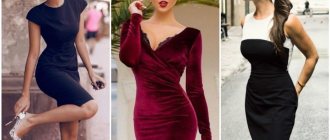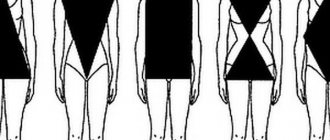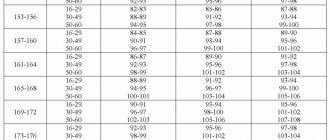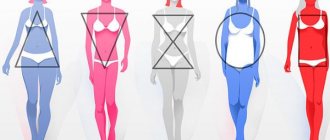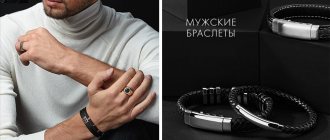Is there such a thing as an ideal female figure? Of course, there is a standard 90x60x90, but it is more of a working standard, a podium standard. In addition, at different times, types of figures that were very contradictory to the modern ideal were valued.
If at first, in the era of antiquity, the most attractive figure was the one with long legs. In the Middle Ages, a woman became a true symbol of motherhood, but with the Inquisition came a new fashion. The love for curvy figures was replaced by close attention to the thinness and pallor of the silhouette. Curvy figures became feminine again only during the Renaissance. At this time, a woman with natural rounded shapes and all the folds and irregularities of the body was considered perfect.
The 20th century figure is a triangle. Women with toned arms and legs, flat stomachs and narrow hips breathed a sigh of relief. But fashion is so fleeting that in the 21st century we again took aim at large busts, ample breasts and a clear waistline.
WHAT FIGURE TYPES ARE THERE?
You can find out your body type by measuring your body proportions. Leonardo Da Vinci spoke about them. His theory about ideal human proportions is used by all fashion designers and stylists, as well as artists. First of all, fashion designers need this to create clothes for any body type.
There are 5 main body types. They depend on the structure of the skeleton, the distribution of fat mass and the shape of the muscles. And also the proportions between the shoulders, chest, waist and hips. You can be very thin or plush, but your body type will still be the same.
1. Rectangle - approximately the same size of the waist, chest and hips.
2. Triangle - shoulders and bust wider than hips.
3. Hourglass - narrow waist, equal bust and hip volume.
4. Apple - approximately the same volume of the waist, chest and hips with a smooth line.
5. Pear - narrow shoulders, wide hips.
Asthenic physique
Asthenic women (ectomorphs) are distinguished by their overall thinness and elongated lines. Their main features:
- long and thin neck;
- narrow shoulders and chest;
- elongated oval face, clear cheekbones, thin nose;
- undeveloped muscles;
- high growth.
Long-legged girls with an asthenic (ectomorphic) physique often lack strength. Endurance is not a strong trait of the asthenic type. At the same time, they are characterized by lightness and grace. Slim girls gain excess weight very slowly, maintaining a slim figure even with an incorrect and unbalanced diet, and quickly get into shape.
Elongated and thin limbs are one of the signs of an asthenic physique.
Bone diseases and spinal problems are common among asthenics. They often experience low blood pressure and reduced hemoglobin levels. In addition, there is a high probability of colds, stomach problems and vegetative-vascular dystonia. Asthenics prefer warmth, avoiding too cold weather.
Carbohydrates should predominate in the diet of androgenic asthenics - 50-60%. Proteins and fats should be supplied in equal quantities - 20-30%. When choosing a sport, give preference to physical activity that will develop the missing characteristics: strength and endurance. For example, swimming and aerobics are good options.
HOW TO DETERMINE YOUR FIGURE TYPE?
Why know your body type? It's simple! To be able to choose an outfit individually to suit your figure. Emphasize your strengths, hide your flaws, look and feel confident.
To find out what body type you are, take a measuring tape and take 3 measurements:
- Hips. We determine them by their widest part, holding the measuring tape parallel to the floor.
- Waist. We determine by the narrowest part, the stomach should be relaxed.
- Breast. We determine the volume using a regular bra, without padding or push-up. We focus on the most convex point of the chest. Don't forget to keep the tape parallel to the floor!
Now you have a more accurate idea of your parameters. Determining your body type:
- If the volume of the chest and hips is the same, or the difference is no more than 4 cm, and the waist is significantly smaller (20-30 cm), then your figure is an HOURGLASS.
- If you have slender legs, and your waist, stomach and chest are much larger than your hips, then your figure is an APPLE .
- If you do not have a pronounced waist, and the volume of your hips and chest is approximately the same, then your figure is a RECTANGLE.
- If you have narrow hips, wide shoulders and chest volume greater than hip volume, then your figure is a TRIANGLE.
- If you have small breasts, wide hips and a narrow waist, then your figure is PEAR.
Weight index
Determining a woman's weight index or body mass index (abbreviated BMI) allows us to assess the compliance of a woman's basic anthropometric indicators - height and body weight - and determine the need for weight correction by changing diet or physical activity.
In general, the formula for calculating the mass index is:
BMI = M/H2,
Where:
- M – weight, kg;
- H2 – height in meters, squared.
For example, if a woman’s height is 1.7 m and her weight is 50 kg, then:
BMI = 50 / (1.7 x 1.7) = 17.
To correlate this indicator with the norm and establish deviations, the following interpretation of values is used (according to WHO):
- up to 16 kg/sq. m – pronounced deficit weight;
- from 16 to 18.5 kg/sq. m – deficient weight;
- from 18.5 to 25 kg/sq. m – weight within normal limits;
- from 25 to 30 kg/sq. m – there is a tendency to obesity;
- from 30 to 35 kg/sq. m – presence of obesity;
- from 35 to 40 kg/sq. m – high degree of obesity;
- from 40 kg/sq. m and more – a pronounced, severe form of obesity.
Accordingly, the resulting value is 17 kg/sq. m falls under the indicator of deficit weight.
This formula has large errors and does not take into account the characteristics of a particular somatotype, which may significantly go beyond the preset BMI values.
Height and weight standards by body type
Women's body types have their own characteristics and distinctive features, based on which the ideal weight norm for each somatotype is determined. Moreover, this norm may vary depending on the age of the woman.
| Height, cm | Permissible weight limit, kg | ||
| for asthenics (ectomorphs) | for normosthenics (mesomorphs) | for hypersthenics (endomorphs) | |
| Up to 148 | 42,5 – 51,2 | 45,3 – 54,9 | 53,4 – 60,0 |
| 148 – 150 | 43,2 – 52,2 | 49,8 – 57,4 | 54,6 – 62,4 |
| 151 – 153 | 44,7 – 52,6 | 51,2 – 57,2 | 53,8 – 62,7 |
| 154 – 159 | 47,2 – 56,3 | 52,1 – 61,3 | 56,4 – 65,8 |
| 160 – 163 | 50,9 – 57,4 | 54,8 – 68,2 | 58,8 – 68,7 |
| 164 – 169 | 52,9 – 61,0 | 57,4 – 65,6 | 62,2 – 72,4 |
| 170 – 173 | 55,6 – 63,1 | 60,2 – 68,3 | 65,1 – 75,7 |
| 174 – 179 | 57,1 – 65,6 | 62,4 – 71,1 | 66,6 – 78,4 |
| 180 or more | 61,2 – 68,7 | 65,3 – 73,6 | 69,7 – 81,6 |
These indicators are suitable for the category of women aged 18 to 35 years. If the age is greater, then to the indicated values you need to add:
- 3 kg for ectomorphs;
- 4 kg for mesomorphs;
- 5 kg for endomorphs.
In this case, the norm is understood as the average value of mass, which can fluctuate in the region of the segment between the maximum and minimum limit points, and differ depending on the formulas used for calculating the ideal weight.
The classic formula for determining BMI taking into account the somatotype
The BMI calculation formula recommended by the World Health Organization has been refined over time and takes into account the somatotype of women.
It looks like:
- for asthenics BMI = (M + 10%) / H2;
- for normosthenics BMI = M / H2;
- for hypersthenics (M – 10%) / H2.
Thus, in the presence of a hypersthenic or asthenic physique, a preliminary adjustment of body weight by 10% is required in the direction of decreasing or increasing, respectively.
For example:
- The woman has an asthenic somatotype with a weight of 47 kg and a height of 162 cm.
BMI = (47 + 10%) / (1.62 x 1.62) = (47 + 4.7) / 2.6244 = 19.7
Accordingly, the weight is within normal limits (according to WHO).
- The woman has a mesomorphic somatotype with a weight of 63 kg and a height of 168 cm.
BMI = 63 / (1.68 x 1.68) = 63 / 2.8224 = 22.3
Which corresponds to normal weight.
- A hypersthenic woman with a weight of 76 kg and a height of 164 cm.
BMI = (76 – 10%) / (1.64 x 1.64) = (76 – 7.6) / 2.69 = 25.4
In this case, there is already a trend towards obesity.
Weight index according to Broca's formula
The fundamental formula for determining the ideal body weight was developed by the French surgeon P. Broca back in the second half of the 19th century.
It looks like this (for women):
IV = Height – 100
For the calculation, take the height value in centimeters.
As we studied somatotyping, significant disadvantages of this method were identified:
- only suitable for the average woman with a height of 155 cm to 175 cm;
- not suitable for female athletes;
- not suitable for women suffering from conditions associated with weight loss or weight gain.
Broca–Brugsch weight index based on body type
The previous formula was modified by the German scientist T. Brugsch for women whose height does not fit into the range of 155 - 175 cm.
- with a height of less than 165 cm, IV = Height – 100;
- with a height of 165 – 175 cm, IV = Height – 105;
- with a height of over 175 cm, IV = Height – 110.
These formulas are suitable for mesomorphic women. For the asthenic type, it is recommended to add 10% to the obtained IV, and for the hypersthenic type, subtract 10% from the result.
For example:
- The woman has a normal (mesomorphic) build with a height of 167 cm.
IW = 167 – 105 = 62 kg – ideal body weight.
- With an asthenic physique with the same height:
IW = (167 – 105) – 10% = 62 – 6.2 = 55.8 kg – ideal weight.
- With a hypersthenic somatotype and a height of 162 cm in a woman:
IV = (162 – 100) + 10% = 62 + 6.2 = 68.2 kg.
Quetelet index taking into account body type and age
According to A. Quetelet, per 1 cm of a woman’s height there is a certain amount of weight, which varies depending on the somatotype and age. The formula involves calculating the ideal weight for women of reproductive age from 15 to 40 years.
The formula looks like:
- IV = K x Height,
where K is the weight coefficient in grams per 1 cm, determined from the table.
| Age, years | Weight per 1 cm of height, g | ||
| Asthenic | Normosthenic | Hypersthenic | |
| 15 – 18 | 315 | 325 | 355 |
| 19 – 25 | 325 | 345 | 370 |
| 26 – 39 | 335 | 360 | 380 |
If you are less than 160 cm tall and under 20 years of age, it is recommended to reduce the result by 10%.
For example:
- The normal weight for a woman 170 cm tall and 30 years old with a hypersthenic physique will be:
IV = 380 x 170 = 64600 g or 64.6 kg.
- The ideal weight for a 17-year-old girl with a height of 165 cm and an asthenic body type will be:
IV = 315 x 165 – 10% = 46.8 kg.
Formula Humvee
A popular way to determine ideal weight is calculated in inches and looks like this (for women):
IV = 45.5 + 2.2 x (Height – 60)
She suggests that the optimal weight for a woman 60 inches (152.4 cm) tall is 45.5 kg. If a woman's height exceeds 60 inches, then for every additional 1 inch there is 2.2 kg of weight.
For a better understanding, you can convert the formula into the usual centimeters, based on the generally accepted values of 1 inch = 2.54 cm. It turns out that for every 1 cm of height (if it exceeds 152.4 cm) there are 2.2 kg / 2.54 cm = 0.87 kg mass.
The final formula in centimeters will look like:
IV = 45.5 + 0.87 x (Height – 152.4)
This option is suitable for calculating the ideal weight for a normosthenic physique. If a woman is asthenic, then 10% must be subtracted from the result obtained, and if she is hypersthenic, then 10% must be added to the total.
For example:
- A woman 165 cm tall has an asthenic body type.
IV = (45.5 + 0.87 x (165 – 152.4)) – 10% = 51 kg.
- The woman is 170 cm tall and belongs to the mesomorphic somatotype.
IV = 45.5 + 0.87 x (170 – 152.4) = 60.8 kg.
The ideal weight of a woman is a rather vague and conditional concept, for the calculation of which many formulas have been invented. Moreover, not all of them take into account belonging to a certain type of physique and are calculated only on the basis of 1 - 2 values, which is why large errors arise.
Information about the acceptable weight norm and knowledge of your somatotype allows you to adjust your appearance, work out problem areas of your figure, determine the right lifestyle and prevent the occurrence of many diseases.
Author of the article: Anna Lalochkina
Article design: Svetlana Ovsyanikova
FIGURE TYPE – PEAR
Narrow shoulders, wide hips
This body type is characterized by a narrow upper body, small breasts, and wide hips. The waist is usually narrow, sometimes low, and very pronounced. The pear has feminine thighs and a flat stomach. Girls with this type of figure have a thin, beautiful neck, model cheekbones and enviable collarbones.
Regardless of fullness, this type of figure remains the same. Fat is deposited mainly in the thighs and buttocks. The plumper a pear girl is, the more pronounced her body type is. The main thing for a pear, no matter how fat, is to maintain posture. This way the body proportions will always look smooth and natural.
In clothing, it is important to choose accents that emphasize the roundness of the hips and thin waist. Full skirts, flared trousers, fitted shirts and jackets, bell-shaped cardigans and dresses with ruffles on the chest will create a light, exciting and stylish look for you. To properly balance your figure, it is recommended to wear blouses with voluminous sleeves and shoulder pads.
Will do
- Fitted outerwear, trapeze coat.
- Any fitted clothing with overhead shoulders (coats, jackets, jackets).
- Blouses, tops and tank tops are off-the-shoulder, sleeveless or with a wide neckline.
- A-line or pencil skirt.
- Dark trousers or straight-fit jeans.
- Trousers or jeans that flare out at the bottom.
Won't fit
- Baggy outerwear, long straight-cut coats.
- Crew neck tops or blouses, turtlenecks.
- Bright massive belts on the hips.
- Tight-fitting trousers or trousers, especially in light colors or with a bright print.
- Trousers or jeans with decorative elements on pockets or waistbands, fluffy skirts, flared skirts.
- Pants or skirts with a lot of weighting elements: lace, ruffles, folds.
How to choose clothes?
When selecting clothes, you must try to eliminate the imbalance between the top and bottom, as well as highlight the winning parts of the figure.
A few rules:
- in order not to focus attention on broad shoulders, you should avoid using shoulder pads, large turn-down collars, and sleeves with ruffles;
- to eliminate the imbalance, you need to emphasize the bottom in every possible way; for this, use clothes with frills, decorative details on the hip line, and light colors;
- Even if the bust is small, you should not try to highlight it by using clothes with flounces, pockets at chest level, ruffles and other decorative elements. These decorative options will focus attention on the upper part of the figure, making the silhouette inharmonious.
But there are also clothing models that should not be in the wardrobe of ladies with an inverted triangle-shaped figure:
- hoodie dresses , in such an outfit it is impossible to highlight the winning parts of the figure, and the silhouette as a whole will be massive;
- mermaid cut dress . This style will not only highlight slender hips, but also reveal a massive top, so the figure will look disproportionate;
- wide cutouts , in the shape of a square or semicircle.
FIGURE TYPE - HOURGLASS
Narrow waist, equal bust and hip volume
Hourglass is the standard body shape for women. It is also called X-type. This type of figure is considered to be a model one. Regardless of whether the owner of the X-type is plump or slim, almost any clothes will look beautiful on her.
With voluminous breasts and buttocks, the hourglass waist is always narrow. Now this is extremely popular, even with extra centimeters. And all because the upper and lower parts of the X-type look organic.
Will do
Almost everything. The most advantageous way to highlight your figure:
- Fitted silhouettes.
- Blouses, coats and raincoats with wraps and belts.
- V-shaped or round neckline on blouses and dresses.
- Pencil skirt, a-line or sun skirt.
- High-waisted jeans and trousers.
- Waist belt as an accessory.
Won't fit
- Baggy clothes that hide the silhouette.
- Straight cut outerwear.
- Dresses or blouses with high or low waist.
- Low-rise jeans or trousers.
FIGURE TYPE – APPLE
Approximately the same volume of waist, chest and hips with a smooth line
Girls with this type of figure are lucky to have slender legs and a neckline that is “the envy of everyone.” Experts note that many women of royal families had this particular type of figure. The smooth lines from the shoulders to the hips will look majestic with the right wardrobe.
Bright makeup, a bold neckline and open legs will divert attention from the voluminous waist. In the time of Rubens, you could be in one of his paintings!
Will do
- A-line coat, outerwear with an A-line silhouette (narrow at the chest and widening at the bottom).
- V-neck blouses or tops.
- Dresses with A-line or wrap.
- Flared trousers and jeans with voluminous pockets.
- Clothes with large details (ruffles, patterns, draperies) below the hip line.
- Plain clothes with vertical darts.
Won't fit
- Very tight or baggy clothing.
- Sleeveless tops and blouses with a crew neck or ties at the neck.
- Turtlenecks, short tops.
- Clothes with bright prints, frills, and decorative elements on the shoulders and stomach.
- Skinny trousers, trousers and jeans without pockets or low rise.
- Tight skirts, pencil skirt.
Which female figure is the most attractive?
There is no one-word answer to this question, because standards for the female form and beauty in general are constantly changing. For example, figurines preserved from the Stone Age have curvaceous shapes. Women of those times were considered beautiful if they had a protruding belly, large buttocks and muscular thighs.
In the era of Ancient Rome, women of the “rectangular” type, but stockier, were considered the standard of beauty. They were supposed to have broad shoulders and a massive chest. The pelvis remained narrow and the waistline was poorly defined.
In the 16th century, plump silhouettes with round bellies, wide hips and ample breasts again became attractive. This trend continued until the 19th century. Then the standard female figure became noticeably smaller and slimmer.
In the early 1990s, “rectangle” girls were in fashion. Many men were attracted to thin women with teenage curves. Closer to 2005, society's preferences changed again. Now people paid more attention to girls with beautiful, athletic proportions.
10 years ago, all representatives of the fairer sex dreamed of having a “triangular” body type. At that time, a healthy lifestyle was in fashion, and well-developed muscles were valued. The girls tried to pump up their six-pack abs. They wanted to look stocky, tough and athletic.
Nowadays the “pear” figure has become popular. Girls spend a lot of time working on their gluteal muscles. They should be wider than the chest, rounded and clearly visible.
Girls have different types of figures and it is impossible to decide exactly what is beautiful and what is not. Much depends on genetic data, lifestyle and physical activity. In addition, body shapes distinguish women from each other, and knowing their body type, each will be able to emphasize their individuality even more by choosing the right clothes.
FIGURE TYPE - RECTANGLE
Approximately the same size of waist, chest and hips
This type of figure has approximately equal shoulders, waist and hips. Most rectangle women tend to be overweight. At the same time, they have very developed muscle memory and therefore have no problems with losing weight when playing sports.
Rectangles suffer from a lack of waist and a protruding belly. This can be easily hidden with clothing. Thick materials and straight silhouettes will highlight your assets.
Will do
- Fitted outerwear, coat with a belt.
- Tops with thin straps, blouses with puff sleeves.
- Jackets or outerwear with straight shoulders.
- Dresses without straps or with a wrap.
- A-line skirt, sun or with a slit.
- Tight-fitting trousers or jeans with a mid or low rise.
- Classic straight trousers or capris.
Won't fit
- Baggy or oversized clothing.
- Clothing that excessively reveals the abdominal area.
- Straight styles of outerwear or dresses.
- T-shirts, sleeveless or crew-neck tops, turtlenecks.
- Leggings, pencil skirts.
FIGURE TYPE – TRIANGLE
Shoulders and bust wider than hips
This body type is usually seen in athletes and dancers. Broad shoulders, large breasts, a wide waist and narrow hips are clear signs of a triangle. Triangle women's legs are always slender.
Of course, with the right wardrobe you can balance your silhouette. It is better to abandon draperies and smooth lines. A clear contour and straight cut will highlight your athleticism.
Will do
- A-line coat.
- Square, V- or U-shaped necklines on dresses, tops or blouses.
- Low-rise trousers or jeans.
- Dresses or tops with a peplum (a frill below the waist).
- Wide massive belts on the hips.
- A-line skirts, wraparound, with pleats or voluminous pockets.
Won't fit
- Long straight coats, baggy outerwear.
- Tops or blouses with a wide boat neckline.
- Bright voluminous sweaters or jumpers.
- Clothes with padded shoulders.
- Blouses or jackets with puffy sleeves.
- Dark straight trousers or jeans, leggings.
- Pencil skirt or ankle length.
If you know which styles are best suited to your body type, then it will be much easier to decide on purchases in an online store or a regular store. You will save time, be less tired, choose the perfect wardrobe and wear a new dress or trousers and skirt to meet your family and loved ones in a better mood!
With love,
your Lady Maria.
